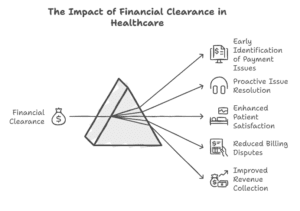Financial clearance is a critical step in the Revenue Cycle Management (RCM) process that ensures healthcare providers are properly reimbursed for the services they provide. It involves verifying and confirming a patient’s financial responsibility, including insurance coverage, co-pays, deductibles, and out-of-pocket costs, before services are rendered. Financial clearance not only ensures accurate billing but also helps prevent financial challenges down the road for both the provider and the patient.
In this article, we explore the importance of financial clearance in optimizing the RCM process, reducing claim denials, improving cash flow, and enhancing patient satisfaction.
Why Financial Clearance Matters in RCM
The RCM process begins with financial clearance and continues through patient registration, insurance verification, coding, billing, and final payment. Financial clearance ensures that the provider knows upfront the patient’s coverage details, which helps reduce the risk of claim rejections and denials. By addressing potential issues early, healthcare providers can ensure smooth reimbursements and avoid financial disruptions later in the cycle.
Key Reasons Why Financial Clearance is Crucial:
- Reduces claim denials and rejections: By verifying insurance details and confirming the coverage, financial clearance helps avoid issues that could lead to claim denials.
- Ensures proper reimbursement: By confirming coverage and financial responsibility, healthcare providers can ensure they are reimbursed correctly for the services rendered.
- Improves cash flow: By clearing financial obligations before services are rendered, providers can reduce delays in payment and enhance cash flow.
How Financial Clearance Optimizes the Revenue Cycle

1. Accurate Verification of Patient Insurance
One of the first steps in financial clearance is verifying a patient’s insurance coverage. This involves ensuring the patient’s policy covers the planned services and checking whether there are any restrictions, co-pays, or out-of-pocket costs that need to be accounted for. How it impacts RCM:
- Accurate coding and billing: With clear insurance verification, the billing team can apply the correct codes and ensure the provider’s services are covered.
- Avoiding patient billing surprises: Patients will know their financial responsibility ahead of time, reducing confusion and preventing disputes over billing after services are rendered.
- Confirming prior authorizations: Some procedures require prior authorization from the insurance company. Financial clearance ensures that all necessary approvals are obtained before treatment.
2. Verifying Patient Financial Responsibility
Financial clearance ensures that the patient is informed about their financial obligations upfront. This includes co-pays, deductibles, and other out-of-pocket costs. How it impacts the RCM process:
- Clear communication: Financial clearance allows healthcare providers to clearly communicate with patients about their financial responsibility before treatment, helping avoid payment delays.
- Patient financial readiness: By confirming what the patient owes, providers can offer payment options or set up payment plans before the service is delivered.
- Improved patient collections: Financial clearance helps streamline the collection process by ensuring the patient is aware of their financial responsibility from the start.
3. Reducing Claim Denials and Delays
One of the most significant challenges in RCM is claim denials. A key part of financial clearance is verifying the patient’s insurance policy and ensuring the correct pre-authorization is in place for services. How it impacts claim denials:
- Preventing coverage errors: Financial clearance helps identify any discrepancies in the coverage before the services are provided, reducing the likelihood of a claim being denied due to insurance issues.
- Improved accuracy: With proper insurance verification and prior authorization, the risk of errors in claims is reduced, which can otherwise lead to delayed or denied payments.
- Pre-emptive solutions: By identifying issues with coverage or authorization upfront, healthcare providers can address them quickly and avoid costly delays in payment.
4. Enhancing Revenue Cycle Efficiency
Financial clearance plays a significant role in optimizing the efficiency of the overall revenue cycle. By verifying insurance details, confirming financial responsibilities, and ensuring accurate coding, providers can streamline the entire billing process. How it impacts efficiency:
- Faster claim submissions: With all financial details clarified upfront, claims can be submitted quickly and without delay.
- Reduced administrative burden: Having financial clearance ensures that the billing department has all the necessary information to process claims, reducing the amount of time spent on research and follow-up.
- Optimized cash flow: By eliminating payment delays and improving the accuracy of claims, financial clearance contributes to more predictable and timely reimbursements.
5. Improving Patient Satisfaction
Financial clearance isn’t just about ensuring timely payments—it’s also about ensuring that patients are informed and satisfied with the billing process. How it improves patient satisfaction:
- Transparent pricing: Patients appreciate knowing their financial responsibility before receiving care, reducing confusion and dissatisfaction after treatment.
- Payment flexibility: Providers can offer payment plans or financing options for patients who cannot afford to pay upfront, improving patient satisfaction and adherence to treatment.
- Reduced billing disputes: With clear financial expectations set upfront, patients are less likely to be surprised by large bills, leading to fewer disputes and complaints.
6. Ensuring Compliance
Financial clearance is also essential for ensuring that healthcare providers comply with regulations and avoid penalties. By verifying insurance coverage, ensuring accurate billing, and obtaining necessary authorizations, providers can avoid compliance violations. How it impacts compliance:
- Regulatory adherence: Financial clearance ensures that all insurance requirements, such as co-pays and authorizations, are met, helping providers stay compliant with payer and government regulations.
- Minimizing legal risks: Ensuring proper billing and payment processes minimizes the risk of legal and regulatory penalties that can arise from billing errors or fraud.
Best Practices for Effective Financial Clearance
To maximize the benefits of financial clearance, healthcare providers should implement the following best practices:
- Integrate financial clearance with RCM: Make financial clearance an integral part of the RCM process by ensuring that insurance verification and patient financial responsibility are addressed early.
- Leverage technology: Use automated systems and RCM software to streamline the financial clearance process, reducing human errors and improving efficiency.
- Staff training: Regularly train staff on financial clearance procedures, insurance verification, and patient communication to ensure that the process is carried out accurately and efficiently.
- Clear patient communication: Ensure that patients are informed of their financial responsibilities ahead of time and have access to payment options and support.
Conclusion
Financial clearance is a vital part of the RCM process that helps healthcare providers ensure timely reimbursement, reduce claim denials, improve cash flow, and enhance patient satisfaction. By verifying insurance coverage, confirming patient financial responsibility, and addressing potential issues early on, healthcare organizations can optimize their revenue cycle and improve their overall financial health. Implementing best practices for financial clearance ensures that both providers and patients are informed and prepared, ultimately leading to a smoother billing process and better financial outcomes.
What People Are Asking
1. Why is financial clearance important in RCM?
Financial clearance ensures that insurance coverage and patient financial responsibility are confirmed upfront, reducing the risk of claim denials, improving cash flow, and optimizing the billing process.
2. How does financial clearance reduce claim denials?
By verifying insurance coverage and obtaining necessary authorizations, financial clearance ensures that the services are covered by the insurance plan, reducing the likelihood of claim denials.
3. How does financial clearance improve patient satisfaction?
Financial clearance helps patients understand their financial responsibility ahead of time, reducing billing surprises, offering payment options, and improving transparency, all of which enhance patient satisfaction.
4. Can financial clearance be automated?
Yes, financial clearance can be automated using RCM software, which streamlines the process of verifying insurance details, confirming financial responsibility, and reducing administrative errors.
5. How can financial clearance improve revenue cycle efficiency?
By ensuring accurate insurance verification and financial responsibility upfront, financial clearance accelerates claim submission, reduces administrative delays, and helps healthcare providers maintain steady cash flow.
Disclaimer
For informational purposes only; not applicable to specific situations.
For tailored support and professional services,
please contact Staffingly, Inc. at (800) 489-5877
Email: support@staffingly.com.
About This Blog: This Blog is brought to you by Staffingly, Inc., a trusted name in healthcare outsourcing. The team of skilled healthcare specialists and content creators is dedicated to improving the quality and efficiency of healthcare services. The team passionate about sharing knowledge through insightful articles, blogs, and other educational resources.
 Book a Demo to Build Your Team Today!
Book a Demo to Build Your Team Today!

 Read Case Studies
Read Case Studies 



 Virtual Medical Assistants
Virtual Medical Assistants



